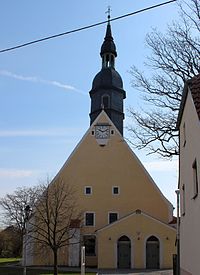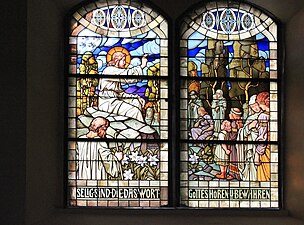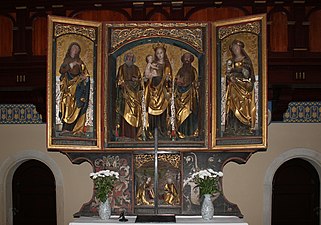Frauenhain village church
The Evangelical Lutheran village church Frauenhain is a Grade II listed church building in the district Frauenhain in the community Röderaue in Saxon district Meissen . The church can be found here in the center of the village.
history
Building description and history
The Frauenhain church is a two-aisled, plastered quarry stone building from the 14th century , with the oldest parts of the building even dating from the 13th century . It was first mentioned in a document in the 15th century . At that time, the Bishop of Naumburg owned a mansion on the site of what would later become the Frauenhain Castle, which he used as accommodation in the region.
In the north of the building there is a side aisle built in 1580 and a sacristy. In the south there is access to an existing patron's box. In the west, a slender octagonal tower with a slate tail hood and weather vane in the form of a ridge was added .
In the years 1733 and 1748 extensive remodeling of the interior and partly of the exterior of the Frauenhain church took place. Renovation work was carried out in 1903 and 1904 under the direction of the architect Fritz Reuter. Restoration work followed from 1976 to 1977.
Parish of Frauenhain
In the middle of the 19th century the parish of Frauenhain included the places Lautendorf , Raden , Treugeböhla , Merzdorf, Kotschka , Gröditz , Pulsen and Seifertsmühl .
Gröditz got its own church in 1890. The place had a strong population growth due to industrialization. Between the years 1848 and 1890 the local population had increased more than fivefold. Kotschka, located directly in front of the town of Elsterwerda , moved to the Elsterwerda parish in 1891 upon request . Treugeböhla was parceled out to Zabeltitz in 1923. In the following year Koselitz, which had previously formed its own parish, was again parished to Frauenhain and the church there has since been a branch church of Frauenhain. In addition, the municipality of Wainsdorf , which is now also in Brandenburg, once belonged to Frauenhain, which had formed its own parish with Prösen since 1903 .
Furthermore, the southern Brandenburg municipality of Merzdorf has been looked after from Frauenhain for centuries . After their separation from Saxony as a result of the Congress of Vienna in 1815, the residents of Merzdorf and Seifertsmühl, which now belong together, successfully defended themselves against the separation of Frauenhain. At the time of reunification , a new community center was built right next to a bell tower built in the 1960s.
In the present day Frauenhain forms with the places Gröditz, Nauwalde , Spansberg , Nieska , Koselitz and Merzdorf to the parish area Gröditz .
Equipment (selection)
Baptismal font (1728)
Inside the church there are galleries dating from the 17th century in the north aisle and in the west and east . The main and north aisles are flat-roofed. Patronage boxes can be found in the north and south walls of the choir with mirror vaults .
In front of the eastern gallery is a late Gothic carved altar from the 16th century , which was probably made in a Grossenhain workshop in 1510 . In the large central field it shows Mary with the child between the two saints Peter and Paul . In the wings of the altar you can see John and Mary Magdalene . On the predella is Nativity shown. The backs of the wings are painted.
The baptism of the church, with its eight-sided dome, dates from 1728. It is made of sandstone and porphyry. The pewter baptismal font dates from 1693 with an inscription. The wooden pulpit can be found on the south wall. An inscription here reminds of the former pastor Zauling, who worked in Frauenhain in the 16th century.
Another fixture in the church is a half-life-size Gothic crucifix from the 16th century.
organ
The organ in the Frauenhain church today dates from 1897. The instrument was created by the Borna organ builder Richard Kreutzbach .
It has a mechanical cone drawer with fourteen registers , which are divided into two manuals and a pedal . The disposition is as follows:
|
|
|
||||||||||||||||||||||||||||||||||||||
- Coupling : II / I, I / P
- Playing aids : 3 fixed combinations (piano, mezzoforte, tutti)
Tombs
Inside the church there are three epitaphs from the 17th and 18th centuries on the south wall .
- Grave stone of sandstone with ganzfigurigem relief of Hans Haubold of Milkau († 1619)
- Gravestone of Dam Siegmund Pflugk († 1705)
There are also some more sandstone tombs on the outside wall of the church.
The church was once surrounded by the Frauenhain local cemetery. This is currently a few hundred meters northwest on Gröditzer Straße. In addition to a VVN memorial, there is also a memorial to the fallen in honor of the villagers who died in the two world wars.
- Sandstone tombs on the south wall of the church
Web links
- The Frauenhainer Church on the homepage of the Evangelical Lutheran Congregation Gröditz
- The Frauenhain Church on the homepage of the Röderaue community website
Notes and individual references
- ↑ a b c d e f The Frauenhain Church on the homepage of the Evangelical Lutheran Congregation Gröditz ( memento of the original from September 14, 2016 in the Internet Archive ) Info: The archive link was automatically inserted and not yet checked. Please check the original and archive link according to the instructions and then remove this notice. , accessed November 11, 2016.
- ↑ a b c d e f g h i j k l m Georg Dehio: Handbuch der Deutschen Kunstdenkmäler - I axes . 2nd Edition. 1996, ISBN 978-3-422-03043-5 , pp. 341 .
- ↑ The Grossenhain, Radeberg and Bischofswerda inspections . tape 7 . Schmidt, Dresden 1841. ( digitized version )
- ↑ The Gröditz Church on the homepage of the Evangelical Lutheran Congregation Gröditz ( memento of the original from September 14, 2016 in the Internet Archive ) Info: The archive link has been inserted automatically and has not yet been checked. Please check the original and archive link according to the instructions and then remove this notice. , accessed November 13, 2016.
- ↑ Luise Grundmann, Dietrich Hanspach: Der Schraden. A regional study in the Elsterwerda, Lauchhammer, Hirschfeld and Ortrand area . Ed .: Institute for Regional Geography Leipzig and the Saxon Academy of Sciences in Leipzig. Böhlau Verlag, Cologne, Weimar, Vienna 2005, ISBN 3-412-10900-2 , pp. 101 .
- ↑ Treugeböhla in the Digital Historical Directory of Saxony , accessed on November 13, 2016
- ↑ Koselitz in the Digital Historical Directory of Saxony , accessed on November 13, 2016
- ↑ a b The Koselitz Church on the homepage of the church district Meißen-Großenhain , accessed on November 9, 2016.
- ^ Klaus Ramm: Church and local history from Prösen and the surrounding area . Ed .: Evangelische Kirchengemeinde Prösen. 2008.
- ↑ a b The Frauenhainer village church on the homepage of the Röderaue community website , accessed on November 12, 2016.
- ↑ Luise Grundmann, Dietrich Hanspach: Der Schraden. A regional study in the Elsterwerda, Lauchhammer, Hirschfeld and Ortrand area . Ed .: Institute for Regional Geography Leipzig and the Saxon Academy of Sciences in Leipzig. Böhlau Verlag, Cologne, Weimar, Vienna 2005, ISBN 3-412-10900-2 , pp. 180 .
- ↑ The Merzdorf Community Center on the homepage of the Evangelical Lutheran Congregation Gröditz ( memento of the original from September 14, 2016 in the Internet Archive ) Info: The archive link was inserted automatically and has not yet been checked. Please check the original and archive link according to the instructions and then remove this notice. , accessed November 13, 2016.
- ↑ Internet presence of the church district of Meißen-Großenhain , accessed on November 9, 2016.
- ↑ a b Organ index of the Frauenhainer Organ (pdf) on the homepage of the church district Meißen-Großenhain , accessed on November 12, 2016.
Coordinates: 51 ° 23 ′ 16.1 ″ N , 13 ° 28 ′ 23.7 ″ E












